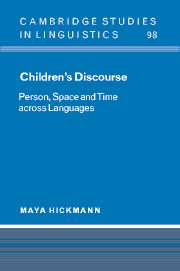Book contents
- Frontmatter
- Contents
- List of figures
- List of tables
- Preface
- List of abbreviations and conventions
- 1 Introduction
- Part I AVAILABLE THEORIES AND DATA
- Part II A CROSS-LINGUISTIC STUDY OF CHILDREN'S NARRATIVES
- 7 Methodological issues
- 8 Animate entities
- 9 Space
- 10 Time
- 11 Conclusions
- Appendix
- Notes
- References
- Author index
- Subject index
11 - Conclusions
from Part II - A CROSS-LINGUISTIC STUDY OF CHILDREN'S NARRATIVES
Published online by Cambridge University Press: 22 September 2009
- Frontmatter
- Contents
- List of figures
- List of tables
- Preface
- List of abbreviations and conventions
- 1 Introduction
- Part I AVAILABLE THEORIES AND DATA
- Part II A CROSS-LINGUISTIC STUDY OF CHILDREN'S NARRATIVES
- 7 Methodological issues
- 8 Animate entities
- 9 Space
- 10 Time
- 11 Conclusions
- Appendix
- Notes
- References
- Author index
- Subject index
Summary
This chapter synthesises the results of the study just presented (Chapters 8 to 10) and compares them with those of previous studies discussed in the developmental literature (Chapters 4 to 6). After a summary of the main findings within each domain (Section 11.1), four general conclusions are drawn across all three domains (Section 11.2). First, the findings show that the development of discourse-internal functions is late and gradual. Second, acquisition is determined by two types of interrelated factors: sentence-internal syntactico-semantic factors and functional determinants governing the regulation of information flow in discourse. Third, although these general aspects of the developmental process can be observed in all languages, others are language-specific, showing the impact of the particular systemic organisation of each language. Finally, a comparison of the findings across domains highlights particular properties of each domain, as well as interrelations among them suggesting that conjoined developments occur in all aspects of discourse cohesion. More general implications are then drawn in the context of available models of language acquisition (Section 11.3). It is argued that language acquisition is a gradual process, which requires that the child relate two levels of linguistic organisation, the sentence and discourse, accounting for invariant as well as variable patterns. This type of multifunctionality is universal and central in explaining how language becomes its own context, despite cross-linguistic variations due to the fact that children must confront the particular ways in which their native language maps sentence and discourse functions onto forms.
- Type
- Chapter
- Information
- Children's DiscoursePerson, Space and Time across Languages, pp. 318 - 342Publisher: Cambridge University PressPrint publication year: 2002

